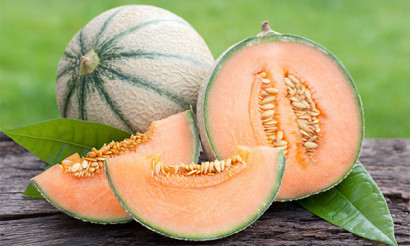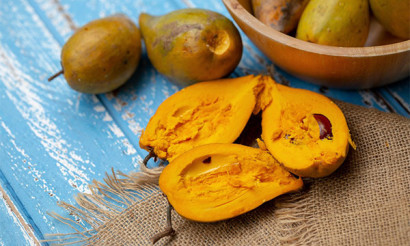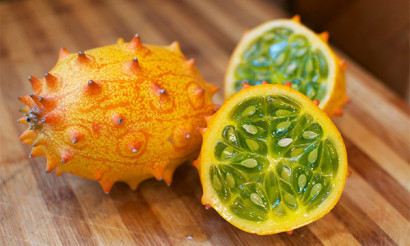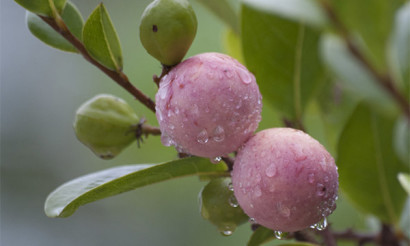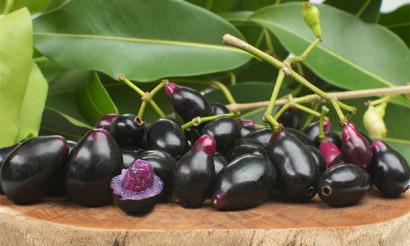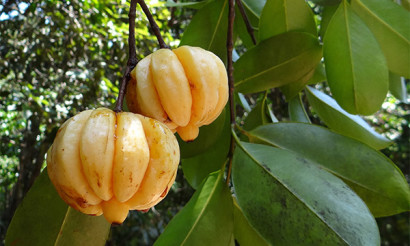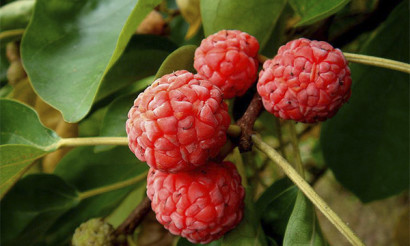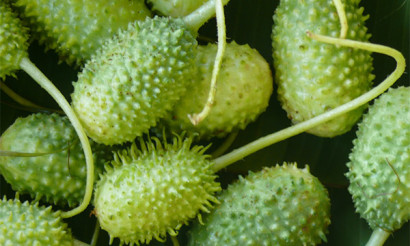Gandaria: what kind of fruit is it and how is it healthy
Travelers visiting the countries of Southeast Asia can try dozens of exotic fruits that are difficult to buy in the stores of the middle band of the Northern Hemisphere. Tender southern fruits do not tolerate transportation and quickly deteriorate. Canned food and other preparations do not allow to evaluate the taste and aroma of southern delicacies. These rare products include the fruits of gandaria.
What is this fruit
Gandaria is a fruit tree of the Anakardiev family, which includes pistachio, mango and sumy. The rounded, elongated fruits of the plant are similar to large apricots. Unripe fruits have a pale green color, sour, tart taste. Viscous pericardium contains sticky milky juice. As they ripen, the fruits become soft, light yellow or orange-yellow. The fruit is 2–7 cm long and weighs 35–100 g. The fruits grow on thin legs and densely cover the branches.
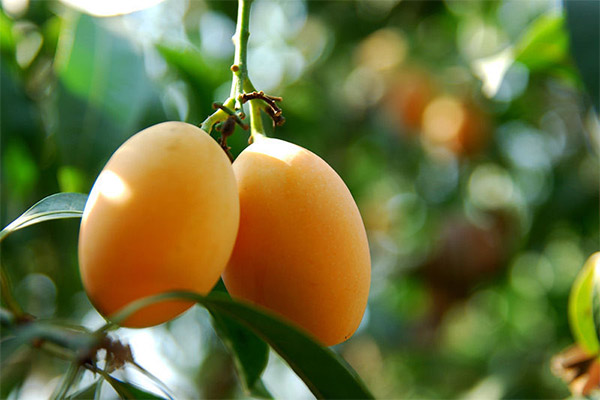
The delicate pulp of ripe gandaria in appearance and texture resembles the plum pulp. It is painted in bright yellow or orange. The ripe fruit has a thin skin, the taste is sweet or sweet and sour, with a slight smell of turpentine (resembles the taste of Alfonso mango).
The cotyledons of the kernel are edible, despite the bitterness and astringent effect. They can be pink, blue or purple.
What does it look like
Gandaria is a tall, sprawling tree with an extensive crown. This evergreen is also called marian plum. In English-speaking countries you can find the names plum mango (plum mango) and mango plum (mango plum). In all Asian countries where gandaria grows, there are local species names.
This powerful tree grows to a height of 27 m, the trunk diameter reaches 50–55 cm. Large dark green leaves of the plant have an elongated shape and pointed tips. The maximum length of sheet plates is 45 cm, width is 12–13 cm.
The yellow gandaria flowers are very small. The average size of oblong ovoid petals is 2–2.5 mm. The fruit of the tree is a drupe, similar to a large bone of its closest relative - mango.
Where grows
The homeland of gandaria is the tropical islands and coast of Southeast Asia. Now this fruit tree is cultivated in Thailand, Laos, Indonesia, Burma, the Philippines. It is grown on the islands of Sumatra, Ambon, Mauritius, Borneo, in the western part of the island of Java. The plant loves fertile soil, lowlands, humid and hot climate. Gandaria is also grown on the intermountain plains, at an altitude of up to 850 m above sea level. Maximum yields are obtained in areas where the average annual temperature is 24 ° C.
In Thailand, gandaria begins to bloom in November-December, and harvesting occurs in April-May. At the equator and to the south, in Indonesia, flowering occurs from June to November, and the fruits ripen in March-June.
What is the fruit good for?
Gandaria is not only an exotic treat. 100 g of fruit contains:
- vegetable proteins - 0.5 g;
- carbohydrates - 11 g;
- fats - 0.2 g.
In the fruit pericardium there are plant fibers, fiber, water, ash components. The calorie content of the product (ripe pulp) is 42 kcal per 100 g. The fruits have iron, phosphorus and calcium and other important trace elements.
Gandaria contains:
- ascorbic acid (vitamin C);
- B vitamins (riboflavin, nicotinic acid, thiamine);
- beta carotene.
The fruit is easily digested, it can be eaten at any time of the day. Marian plum has not only nutritious, but also healing properties:
- The pulp of the fetus is saturated with water. Juice accelerates metabolic processes, quickly removes toxins and waste from the body.
- Fiber in fruits and leaves helps cleanse the intestines.
- Vitamins enhance metabolism, participate in collagen formation processes, improve the condition of hair and skin, increase immunity, and ensure the normal functioning of all body systems.
- Beta-carotene is important for good vision and healthy skin.
Low calorie content of the product, a large amount of fiber and water allows you to include the product in the menu of the fasting day. To prevent bowel disease, you need to eat at least 26 g of fiber per day. Regular consumption of marian plum reduces the risk of the formation of polyps and tumors of the gastrointestinal tract.
Which may be harmful
Gandaria can be eaten without restrictions if there is no individual allergic reaction to the product. But a person who has eaten a large number of fruits may experience the following troubles:
- diarrhea;
- nausea;
- yellowing of the proteins of the eyes and skin;
- heartburn;
- muscle cramps;
- rash and itching;
- joint and muscle pain.
If you adhere to the daily intake of fruit, there will be no unpleasant consequences. Gandaria is best served as a dessert, not a main course.
How to eat gandaria
Eat the flesh of ripe and green fruits, as well as young leaves. You can use large, large sheets, but they have a lot of hard fibers. Strongly bitter kernel kernels are also suitable for food.

Ripe fruits are especially tasty fresh. Gandaria is thoroughly washed in running water and eaten (like a plum). Large fruits can be cut in half and the seeds taken out. Peeling is not necessary.
The leaves of the tree are edible both fresh and boiled. Young leaves are cut into pieces, like vegetables, added to rice and salads. Bitter seeds are used as a spicy additive in sauces.
Green and unripe fruits are also edible. The product improves the taste and aroma of curry, Thai and Indonesian dishes, including rojak and asinana. Unripe fruits are added to fruit salads and sauces, pickled with herbs and vinegar.
What can be made from gandaria
At home, you can cook a fruit salad and add slices of ripe gandaria to it. This fragrant fruit successfully replaces mangoes.
From ripe fruit, you can cook jam, compote, make jelly. Fragrant yellow jam is used as a filling for an open cake, as well as for decorating cakes. Jam from gandaria can be added to shortbread dough. Fruit slices diversify cold homemade lemonade. Sour green gandaria are added to the jar when pickling and pickling cucumbers.
In Indonesia, ripe fruits of Marian plum make jam and halva. Ripe gandaria is dried, it is a good snack for alcoholic drinks.
Gandaria is a popular component of the traditional dishes of Southeast Asia - rojak, asinana and sambala.
Fruit rojak is made from tofu cheese and tropical fruits - pineapple, mango, gandaria, pomelo. This is a vegetarian version of the dish. Tropical fruits are peeled, cut into medium-sized pieces and watered with spicy, sweet peanut sauce. This dish is not difficult to cook at home. Fruit rojac is served immediately after cooking.
Fruit asinan Bogor is a delicious dessert dish that can be enjoyed in Indonesia (or cooked in your own kitchen). The food is prepared from a mixture of canned fruits - Javanese apple, mango, gandaria, pineapple, ambarella, papaya. The mix also includes fresh tubers of the jicama bean plant. The fruit mixture is poured with liquid sweet-sour sauce, which includes vinegar, peanuts, nutmeg and chili.
Sambal - spicy Indonesian sauce. The main ingredients of the product are fresh chili peppers and salt, which are ground in a mortar until a homogeneous paste is obtained. Seeds from peppers are not removed. Dozens of foods and spices are added to this hot base. In sambal you can put red tomatoes, lime, ginger, gandaria, garlic and other components. You can find many recipes for this spicy seasoning. For sambal sauce, unripe gandaria fruits are taken. The acidic green flesh is ground together with the bitter kernels of the seeds.
Application in traditional medicine
On the sites of folk healers, you can find tips on using Marian plum as a remedy for headaches. It is recommended to make "poultices from the leaves", but there are no exact recommendations for the preparation and use of the decoction. The same tool is recommended for use in arthritis and osteochondrosis.
Application in cosmetology
The ripe fruit pulp can be added to any nourishing mask. Gandaria contains organic acids that have a beneficial effect on the skin. Cosmetic companies use fruit extracts to produce creams, pastes, masks, lotions, and other hair and skin care products.
Gandaria is one of the main components of the Frangipani and Marian Plum cosmetic product line. For the preparation of extracts, seeds and pulp of fruits are used. The range includes masks, balms, spray, shampoo, oils and creams. The mask is designed to nourish mature skin prone to wrinkles. Hydrophilic oil is suitable for removing makeup and dissolving sebum, cream - for moisturizing aging skin.
How to grow
Gandaria can be grown from the seeds of an overripe fetus. When propagating in a natural climate, on farms, cuttings and layering are more often used. Young shoots can be planted on mangoes.
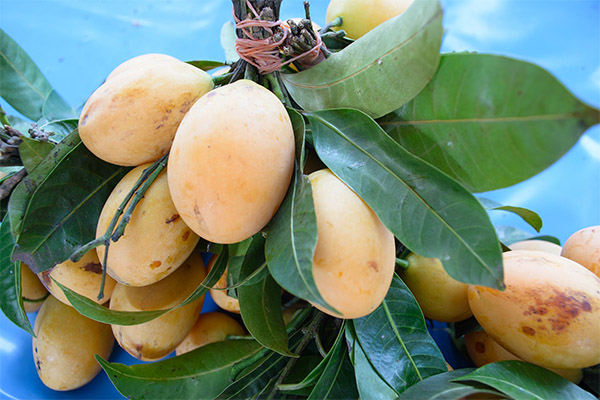
Seed is planted in a small pot. At the bottom of the vessel, holes are made and drainage is placed in it, then nutrient soil is poured. It is better to buy a ready-made soil mixture for tropical plants.
The same conditions are created for gandaria as for mangoes. The earth should be moist, but not flooded. Optimum ambient temperature - plus 24 ° C. The pot is tightened with a transparent plastic wrap. In the "greenhouse" sprouts will appear after 7-10 days.
In winter, the plant is “illuminated” using a bright LED lamp. At the equator, the day lasts 12 hours, so in winter you can not leave the lamp on for a longer time.
In a tropical climate, gandaria begins to bear fruit at the age of 8–10 years, grafted trees give the first fruits for the 6–8th year. In an apartment you can hardly get a crop. But a beautiful lush tree will decorate any interior.
In adult specimens, a thick, lush crown grows. Therefore, gandaria is used not only as a fruit tree, but also as a decorative tree, giving a dense shadow.
«Important: all information on the site is provided exclusively in fact-finding purposes. Before applying any recommendations, consult with a profile specialist. Neither the editors nor the authors are liable for any possible harm caused materials. "

